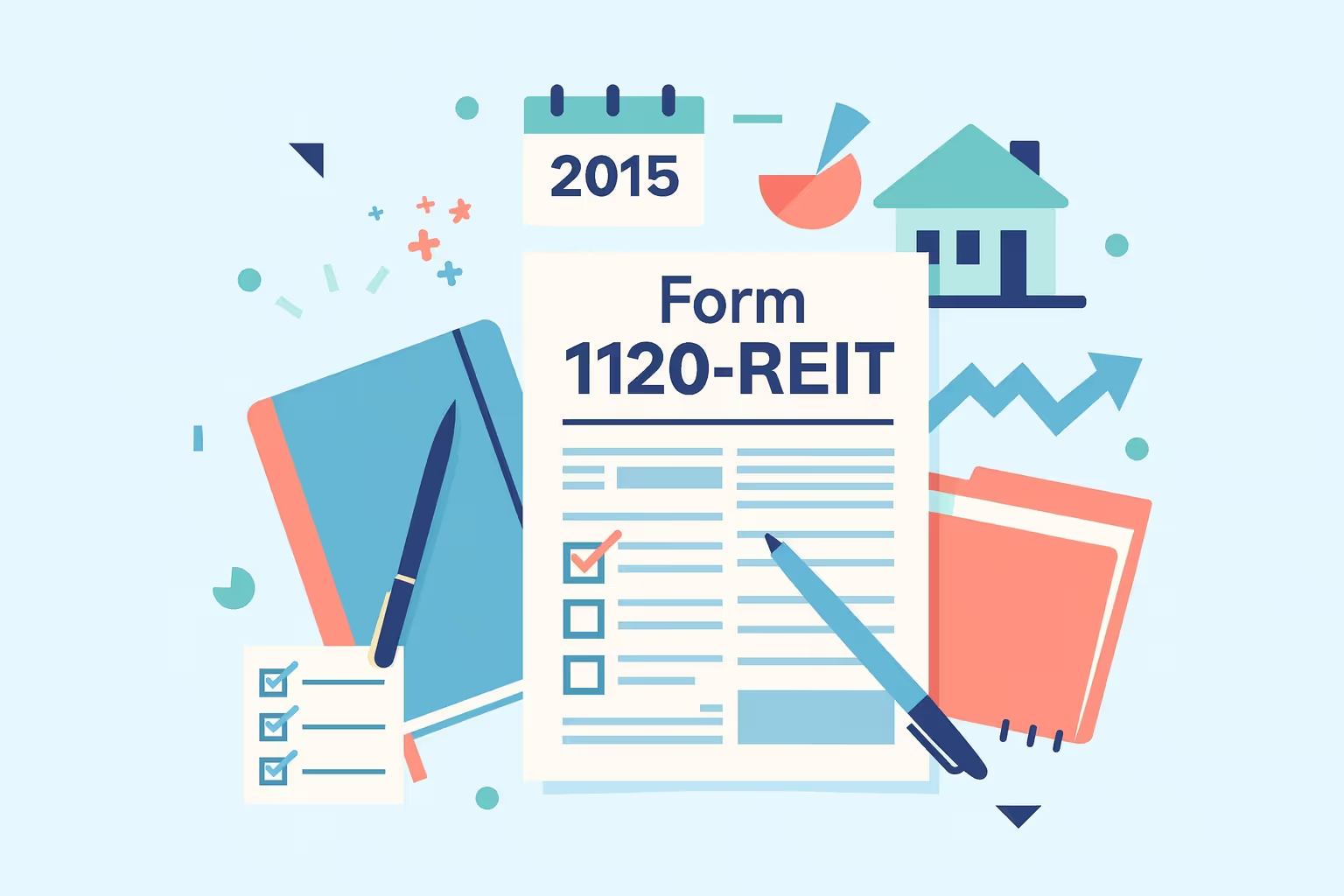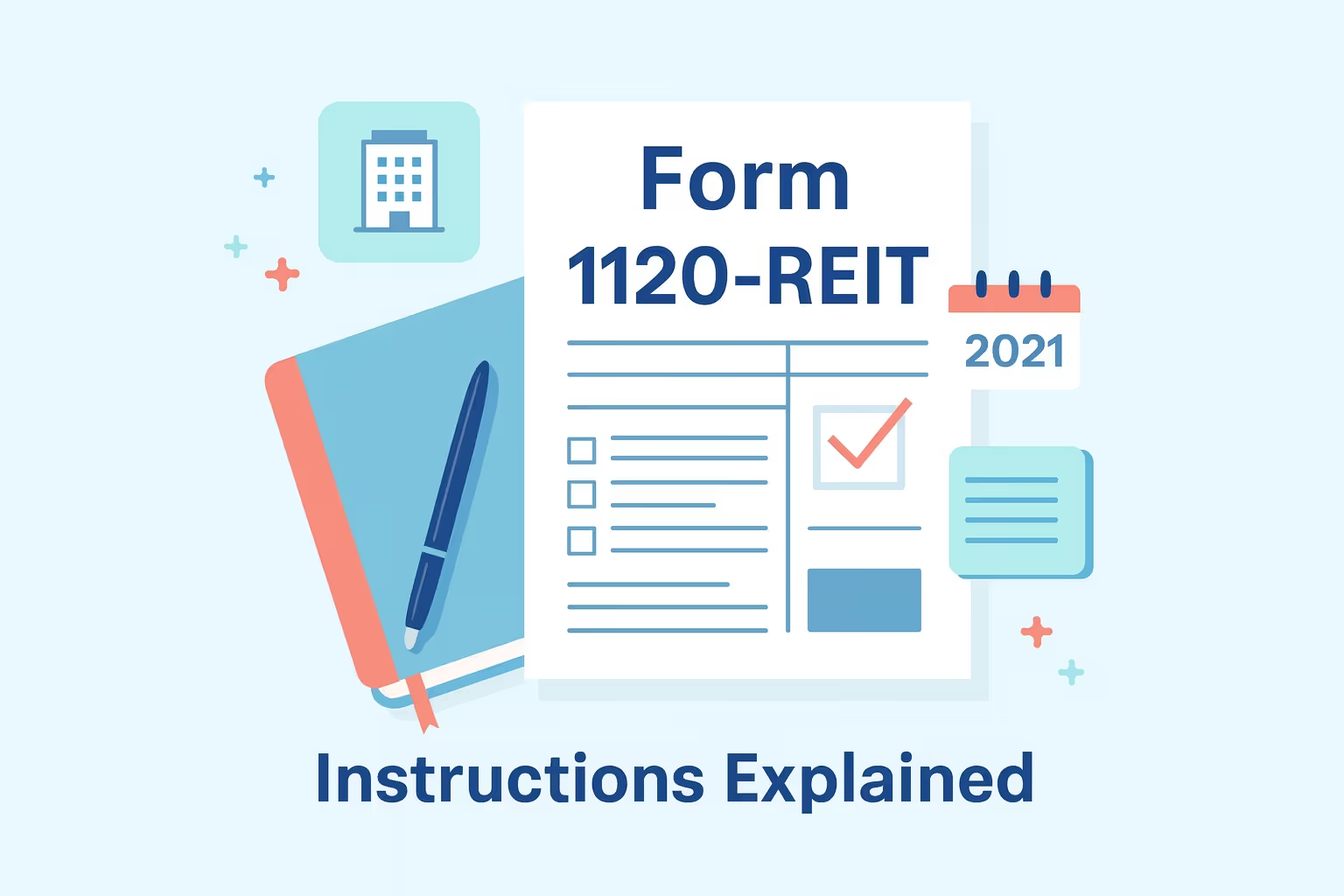
Form 1120-REIT is the official income tax return that real estate investment trusts must file each year to report taxable income, deductions, and distributions. For the 2012 tax year, the IRS issued updated filing guidance that REITs must follow to remain compliant. These requirements are outlined in the Form 1120 REIT 2012 instructions, which detail how corporations, trusts, or associations electing REIT status should prepare and submit their return. The purpose of this filing is not only to calculate total tax owed but also to demonstrate compliance with REIT qualification rules such as distribution thresholds and asset tests.
Filing this return correctly is essential because errors can result in penalties, interest, or delays in the processing of your return. REITs that fail to calculate estimated tax correctly may also face an estimated tax penalty if payments fall short of the required amount during the current year. The IRS requires payment of tax by the due date, even when an extension is requested. Businesses must be aware that underpayment or late payment can result in additional charges. At the same time, timely filings allow them to avoid penalties and receive a refund when credits or withholdings exceed their liability.
This guide explains how to file, what information is required, and the changes that were applied in 2012. It is designed for corporations and businesses unfamiliar with the process, offering step-by-step instructions, examples, and updated information directly from the IRS. Readers will learn how to calculate liability, request extensions, make estimated payments, and file their tax return accurately to stay compliant with federal rules.
Overview of Form 1120-REIT
Form 1120-REIT is the federal income tax return that real estate investment trusts must file with the Internal Revenue Service. This form is required for corporations, trusts, or associations that elect REIT status and continue to operate as a REIT in the current year. Filing is necessary to report taxable income, deductions, distributions, and other tax-related information.
Purpose of the Form
- It is used to calculate total tax liability and determine whether a REIT owes payment or is entitled to a refund.
- It allows REITs to claim credits, report estimated tax payment activity, and disclose any penalties or interest charges that may be incurred.
- It demonstrates compliance with ongoing qualification tests, including the 90 percent distribution rule, income tests, and asset requirements.
- It helps avoid an estimated tax penalty by documenting timely and accurate payments throughout the year.
Who Must File?
- A corporation or trust that has elected REIT status and has not revoked or lost that status is required to file.
- Financial institutions or insurance companies are not eligible to file as REITs.
- Businesses that transition from other structures, such as S corporations or partnerships, must file if they have chosen REIT classification.
The Form 1120 REIT 2012 instructions provide specific guidance tailored to that tax year. By following them closely, corporations and businesses can avoid errors, file their tax return accurately, and ensure all required information is included.
What’s New for Tax Year 2012?
The Internal Revenue Service made several updates that affected the way REITs prepared their income tax return for the 2012 filing year. These changes were outlined in the Form 1120 REIT 2012 instructions and applied to both existing and newly elected REITs.
- Form 1125-E requirement. For the first time, REITs with total receipts of $500,000 or more that deducted officer compensation were required to complete Form 1125-E. This ensured accurate reporting of payments made on behalf of officers and created greater transparency in executive pay.
- Built-in gains tax changes. For tax years beginning in 2012 or 2013, the recognition period for built-in gains was reduced from 10 years to 5 years. This affected businesses that converted from corporations to REITs and needed to calculate tax on prior gains.
- Other updates. Adjustments were made to income and asset test requirements, along with changes to penalty calculations. These revisions highlighted the IRS’s focus on ensuring REITs met qualification standards and avoided errors that could result in additional tax liability.
These updates reinforced the importance of following the correct instructions and ensuring all calculations were completed with the most current year rules in mind.
Step-by-Step Filing Instructions
The IRS requires corporations and businesses that elect REIT status to follow clear steps when preparing their income tax return. Using the Form 1120 REIT 2012 instructions ensures accurate filing and helps avoid penalties.
Step 1: Gather Required Information.
- Collect financial statements and prior year returns.
- Gather officer compensation details for Form 1125-E if required.
- Include distribution records, depreciation schedules, and supporting documents.
Step 2: Complete Header Information.
- Enter the REIT’s legal name, address, and employer identification number.
- Provide the date of incorporation and total assets.
- Indicate whether the return is final, amended, or has a name change.
Step 3: Calculate REIT Taxable Income.
- Report gross rents, interest, dividends, capital gains, and other income.
- Subtract deductions such as compensation, depreciation, taxes, and interest.
- Determine taxable income before the dividends-paid deduction.
Step 4: Compute Tax Liability.
- Apply the dividends-paid deduction to reduce taxable income.
- Calculate tax owed on remaining income.
- Add built-in gains tax, penalties, or excise tax if applicable.
Step 5: Complete Additional Parts and Schedules.
- Fill in sections on foreclosure property, prohibited transactions, and distributions.
- Attach all required schedules, forms, and statements in proper order.
Completing these steps carefully helps corporations file their tax return accurately, pay the correct amount of tax, and avoid penalties or delays.
Filing Methods and Deadlines
REITs have two options for submitting Form 1120-REIT: electronic filing or paper filing. The choice depends on the size of the corporation and IRS requirements.
Electronic Filing (E-file)
- Large corporations with total assets of $10 million or more and at least 250 returns in the current year are required to e-file.
- E-filing provides faster processing and reduces errors through IRS validation checks.
- Businesses receive electronic confirmation that their tax return was received.
Paper Filing
- Paper returns must be mailed to the Internal Revenue Service Center in Ogden, Utah.
- Filers should confirm the mailing address on the IRS website, as addresses are updated regularly.
- When sending a payment by check or money order, filers must include the employer identification number, the tax year, and the REIT’s name on the payment to ensure proper credit.
Deadlines
- The due date for filing is the 15th day of the third month following the end of the tax year. For calendar year filers, this was March 15, 2013.
- An extension of up to six months may be requested by submitting Form 7004.
- Even with an extension, any estimated tax payment must still be made by the original deadline to avoid interest or penalties.
By following the correct filing method and meeting the due date, corporations can avoid penalties and ensure their income tax return is processed without delay.
Payment Requirements
REITs must pay all tax owed by the due date, regardless of whether an extension to file is requested. Timely and accurate payments help avoid penalties, interest, and delays in the processing of payments.
Payment Methods
- The Electronic Federal Tax Payment System (EFTPS) allows corporations to make secure online payments. Payments must be scheduled by 8 p.m. Eastern Time on the due date to be considered timely.
- A check or money order may be mailed along with the return or payment voucher. Filers must make the payment payable to the United States Treasury and clearly include the employer identification number, tax year, and REIT name.
- Credit card or bank transfer payments can be made through authorized third-party processors. Although convenient, these options may involve additional processing fees.
Estimated Tax Payments
- REITs that expect to owe $500 or more for the current year are required to make quarterly estimated tax payments using Form 1120-W.
- If a REIT fails to make accurate payments throughout the year, the IRS may impose an estimated tax penalty. The penalty is based on whichever is smaller: the full amount of tax owed for the current year or the tax owed from the prior year.
- Payments can be reduced by applying withholdings or credits, but corporations should calculate carefully to ensure they do not underpay.
Making all required payments on time ensures compliance and prevents the imposition of unnecessary charges.
Required Schedules and Attachments
The IRS requires REITs to attach specific schedules and forms to Form 1120-REIT. Following the proper order is crucial for accurate processing and preventing delays.
Mandatory Attachments Order
- Schedule N, Stock Ownership in Foreign Corporations, must be included if applicable.
- Schedule D, Capital Gains and Losses, must be attached if the REIT reported sales or exchanges of capital assets.
- Schedule O, Consent Plan and Apportionment Schedule, must be included when required by law.
- Form 4626, Alternative Minimum Tax, is attached if applicable.
- Form 4136, Credit for Federal Tax Paid on Fuels, must be filed when claiming credits.
- All other schedules should be included in alphabetical order, followed by additional forms in numerical order.
- Supporting statements and attachments must be provided to explain or substantiate entries on the return.
Commonly Required Forms
- Form 1125-E, Compensation of Officers, must be filed if the REIT’s receipts are $500,000 or more.
- Form 4562, Depreciation and Amortization, is required for REITs claiming deductions for depreciation and amortization expenses.
- Form 5471, Information Return of U.S. Persons with Respect to Certain Foreign Corporations, may be required for REITs with foreign corporate interests.
- Form 8865, Return of U.S. Persons with Respect to Certain Foreign Partnerships, is needed if the REIT holds qualifying foreign partnership interests.
- Form 8621, Information Return for Passive Foreign Investment Companies, must be filed for interests in passive foreign investment companies.
Corporations must also include detailed income and expense statements, depreciation schedules, and calculations for distributions. Providing complete documentation in the correct order ensures that the IRS has all the necessary information to process the return.
Common Mistakes to Avoid
Errors on Form 1120-REIT can cause delays, lead to penalties, or, in severe cases, threaten the REIT’s tax status. Being aware of frequent mistakes helps corporations prepare a more accurate tax return.
Calculation Errors
- Many REITs make simple mathematical errors when calculating income, deductions, and credits. Double-checking all entries helps prevent misreporting.
- Some filers misapply the dividends-paid deduction, which can result in underpayment or overpayment of total tax.
- Transposed numbers or rounding mistakes often cause discrepancies that delay processing or trigger penalties.
Qualification Issues
- Failing to meet the 90 percent distribution requirement can jeopardize REIT status and impose additional tax liability.
- Errors in applying the 75 percent and 95 percent income tests are typical and must be carefully avoided.
- REITs sometimes fail to maintain required asset ratios, which can result in disqualification or corrective measures imposed by the IRS.
Filing and Documentation Errors
- Missing required schedules or forms, such as Form 1125-E, often results in incomplete submissions.
- Attaching documents in the wrong order creates confusion and processing delays.
- Some filers neglect to sign the return, date the submission, or provide preparer details, making the return invalid.
- Using the incorrect tax year or filing period results in rejection and necessitates correction.
Deadline Mistakes
- Filing after the due date subjects the REIT to late filing penalties and possible interest charges.
- Paying tax late or failing to make an estimated payment increases the risk of an estimated tax penalty.
- Overlooking distribution deadlines may cause a REIT to fail required qualification tests.
By thoroughly reviewing all sections, following the Form 1120 REIT 2012 instructions, and maintaining accurate records, corporations can avoid errors and file their income tax return with confidence.
Zero Activity or Dormant REITs
Even when a real estate investment trust has little or no activity during the year, it may still be required to file Form 1120-REIT. The IRS expects REITs that have elected REIT status to maintain compliance, regardless of whether they had income or distributions during the current year.
Filing Requirements for Inactive REITs
- A REIT must complete the basic identifying information on the income tax return, including the employer identification number, business name, and address.
- Income and deduction lines should be reported as zero where applicable.
- Required schedules must still be attached, even if they contain only zero amounts.
- A supporting statement should be included to explain the lack of activity during the year.
Maintaining REIT Status During Dormancy
- REITs must continue to meet organizational and ownership tests even when no income is generated.
- Asset ratios must be monitored to ensure they comply with IRS requirements.
- Although income tests may not apply during periods with no revenue, the REIT must be prepared to satisfy them once operations resume.
Inactive REITs may choose to maintain their status for future reactivation, revoke the election to avoid ongoing obligations, or dissolve the entity entirely. Careful planning is required to avoid unnecessary penalties or compliance failures.
First-Time Filer Guidance
New REITs must make the REIT election by filing Form 1120-REIT for the first year they want the election to take effect. Understanding the process and preparing properly ensures compliance from the beginning.
Preparation Steps
- A new filer should review IRS Publication 550 and the Form 1120 RET 2012 instructions to understand investment income rules and filing requirements.
- Professional tax preparation assistance can be beneficial in avoiding costly mistakes.
- Establishing a reliable record-keeping system ensures accuracy in reporting future tax years.
Common First-Year Challenges
- Many new REITs struggle with complex income and asset test calculations.
- Planning distributions to satisfy the 90 percent rule can be difficult without prior experience.
- Tracking shareholder ownership requirements often requires careful monitoring and documentation.
Key Areas of Focus
- Corporations should ensure they meet all qualification tests and continue to do so each year.
- Planning for distributions early helps avoid last-minute compliance issues.
- Maintaining accurate governance structures and shareholder tracking systems is essential.
Taking proactive steps during the first filing year makes it easier for REITs to remain compliant and avoid penalties in subsequent years.
REIT Qualification Tests
To maintain tax-advantaged REIT status, entities must pass several qualification tests each year. These rules are designed to ensure that REITs primarily operate in real estate and distribute income to shareholders.
Organizational Requirements
- The REIT must be a corporation, trust, or association that is managed by a board of directors or trustees.
- Shares or certificates must be transferable.
- The entity must be taxable as a domestic corporation and cannot be classified as a financial institution or insurance company.
Ownership Tests
- The 100 shareholder test requires a REIT to have at least 100 shareholders during the last half of the taxable year.
- The 5/50 test ensures that five or fewer individuals own no more than 50 percent of the REIT’s shares.
Income Tests
- The 75 percent income test requires at least 75 percent of the REIT’s gross income to come from real estate-related sources such as rents or property sales.
- The 95 percent income test requires at least 95 percent of gross income to come from the sources allowed under the 75 percent test, as well as dividends, interest, or securities.
Asset Tests
- At least 75 percent of assets must consist of real estate, cash, or government securities.
- No more than 25 percent of assets may be securities that are not real estate-related.
- No more than 5 percent of assets may be securities of any one issuer, and the REIT may not hold more than 10 percent of the voting power of any single issuer.
Meeting these qualification tests each year is required to retain REIT status. Failure to do so may impose penalties or even the revocation of the REIT election.
Distribution Requirements
REITs must distribute a large portion of their taxable income to maintain REIT status. The IRS uses this rule to ensure that REITs act primarily as pass-through entities for shareholder benefit.
Minimum Distribution Requirement
- A REIT must distribute at least 90 percent of its taxable income, excluding net capital gains.
- This distribution can be made in the form of ordinary dividends, capital gain dividends, or other approved forms.
- If the REIT fails to distribute the required amount, penalties may be imposed, and REIT status may be at risk.
Timing of Distributions
- Distributions must generally be made during the tax year.
- In some cases, dividends paid in January may count toward the prior year’s requirement if specific IRS rules are met.
- Deficiency dividends may be used to cure shortfalls, but these require approval and may still result in penalties.
Example of Distribution Calculation
- If a REIT reports taxable income of $1,000,000 and $100,000 in net capital gains, then $900,000 is subject to the 90 percent requirement.
- The REIT must distribute at least $810,000 to shareholders to comply with IRS rules.
Meeting distribution requirements on time helps REITs avoid penalties, retain favorable tax treatment, and maintain investor confidence.
Excise Tax Considerations
In addition to regular income tax rules, REITs may be subject to a separate excise tax under Section 4981 if they fail to distribute sufficient income in a calendar year.
Excise Tax Calculation
- The excise tax equals 4 percent of the shortfall between the required distribution and the actual distribution.
- The required distribution includes 85 percent of ordinary income, 95 percent of capital gain net income, and any undistributed amounts carried forward from prior years.
Avoiding Excise Tax
- REITs should monitor distributions quarterly to confirm compliance with excise tax requirements.
- Dividends paid in January may be counted toward the prior year if properly elected.
- Careful planning is necessary for REITs with non-calendar tax years since excise tax rules use calendar year amounts.
Filing Requirement
- If a REIT owes excise tax, it must file Form 8612, Return for Excise Tax on Undistributed Income of Real Estate Investment Trusts.
Planning distribution schedules carefully allows REITs to avoid additional charges and maintain tax efficiency.
Final Filing Checklist
Before submitting Form 1120-REIT, corporations should perform a final review to ensure accuracy and completeness.
Pre-Submission Review
- Verify that all parts of Form 1120-REIT are filled out and signed.
- Confirm that all required schedules and attachments are included in the correct order.
- Ensure that Form 1125-E is attached if receipts are $500,000 or more.
- Double-check that REIT qualification tests are documented and met.
- Review all distribution requirements to confirm compliance.
- Confirm that tax payments have been made as a whole or scheduled through EFTPS.
- Retain a copy of the return and supporting documents for records.
- If a tax preparer is used, confirm that all preparer information is included.
Completing this checklist helps businesses avoid errors, prevent penalties, and ensure that their income tax return is processed without delay.
Frequently Asked Questions
What is the Form 1120 REIT 2012?
The Form 1120 REIT 2012 instructions explain how corporations and businesses classified as REITs must complete their income tax return for that year. These instructions provide details on how to calculate total tax, report credits, request a refund, and avoid penalties. They also describe required schedules, due dates, and examples that help filers calculate payments and honor compliance standards.
When is the due date for filing a REIT income tax return?
The due date for Form 1120-REIT is the 15th day of the third month after the close of the tax year. For calendar year corporations, this date was March 15, 2013. A filer may request an extension with Form 7004, but the estimated tax payment must still be made by the original date to avoid interest or penalties that the IRS may impose.
How does a REIT handle estimated tax payment requirements?
A REIT that expects to owe $500 or more for the current year must make quarterly estimated tax payments using Form 1120-W. Credits or withholdings may reduce costs, but underpayment may result in an estimated tax penalty. Filers should calculate carefully, using the lesser of the current year's tax or prior year liability, and pay whichever is required on time.
What is an estimated tax penalty, and how can it be avoided?
An estimated tax penalty is imposed when a REIT fails to pay enough of its total tax liability during the year. This can occur through underpayment or late payment. To avoid penalties, businesses should calculate required payments, consider monthly or quarterly schedules, and ensure they pay on behalf of the REIT before the due date. A waiver may be available in some instances.
Can a REIT receive a refund after filing its tax return?
Yes, a REIT may receive a refund if its payments, credits, or withholdings exceed the total tax due for the year. The IRS issues refunds after verifying the return and applying payments. The refund amount depends on the balance between tax owed and tax already paid. Filers should carefully review the return and visit the IRS website, which displays a locked padlock icon for security purposes.
Do financial institutions or S corporations qualify to file as REITs?
Financial institutions and insurance companies are not eligible to file as REITs. Similarly, S corporations and partnerships cannot file directly as REITs, though they may restructure or convert. Only corporations, trusts, or associations that meet the REIT qualification tests can file Form 1120-REIT. Entities should refer to the instructions and updated IRS information pages, often marked with “page last reviewed or updated,” for complete details.



































